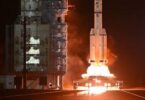Monitoring Desk
NEW DELHI: India announced on Tuesday the names of four astronauts who will take part in the Gaganyaan mission — the country’s first human space flight program.
Having become the fourth nation ever to soft-land a spacecraft on the moon in August last year, India aims to put an astronaut on the lunar surface by 2040.
The Indian Space Research Organization, the state-run agency spearheading the program, aims to launch the mission in 2024-2025.
The astronauts — Indian Air Force pilots Gp. Capt. P. Balakrishnan Nair, Gp. Capt. Ajit Krishnan, Gp. Capt. Angad Pratap and Wg. Cdr. S. Shukla — were introduced to the public by Prime Minister Narendra Modi at the Vikram Sarabhai Space Centre in Thiruvananthapuram, Kerala.
“They are not just four names or four human beings, they are the four powers that are going to take the aspirations of 1.4 billion Indians to space. An Indian is going to space, after 40 years. This time, the time is ours, the countdown is ours and the rocket is also ours,” he said.
“We are witnessing another historic journey at Vikram Sarabhai Space Centre.”
Modi was referring to Rakesh Sharma — the only Indian citizen to travel in space, who flew aboard Soyuz T-11 on April 3, 1984, as part of the Soviet Interkosmos program.
Like Sharma, the four astronauts have also undergone training at the Yuri Gagarin Cosmonaut Training Center in Zvezdnyi Gorodok near Moscow.
The Gaganyaan mission, estimated to cost over $1 billion, began in 2006 with the aim of developing the technology needed to launch crewed orbital spacecraft into low Earth orbit.
The first crewed flight is expected after three uncrewed ones this and next year. Two or three of the astronauts will be launched to an orbit of 400 km for three days and brought back to Earth — landing in Indian sea waters.
If the mission is successful, India will become the fourth nation to conduct independent human spaceflight after Russia, the US and China.
Before it sends an astronaut to the moon, India’s space agency also intends to start a space station program.
“By 2035, India will have its own space station in space that will help us study the unknown expanses of space,” Modi said.
“This is the beginning of a new era, where India is continuously expanding its space in the global order and this is clearly visible in our space program.”
The Gaganyaan mission adds to India’s status as an emerging space superpower, building on a historic success in August 2023, when it landed the moon rover Chandrayaan-3 on the lunar surface, becoming the first country to land near the lunar south pole and the fourth to land on the moon — after the US, Russia, and China.
Weeks after the soft-landing, India launched the Aditya-L1 spacecraft, which in January reached Lagrange point — 1.5 million km from the Earth — where it can orbit the sun at the same rate as the Earth and observe the photosphere and chromosphere to study solar wind particles and magnetic fields.
To date, the US is the only other country to have explored the sun with the Parker Solar Probe launched in 2021.







